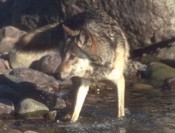 Wolves WolvesWolf History, Conservation, Ecology and Behavior
[www.wolfology.com]
|
Phase Dependence and Population Cycles in A Large-Mammal Predator-Prey System
Post, E.; Stenseth, N.; Peterson, R.O.; Vucetich, J.A.; Ellis, A.M., Ecology, 83/11 (November 2002), 2997
Specialized enemies, such as predators and parasitoids, play an important role in the population cycles of small animals by generating delayed density dependence. We investigated the role of predation in population cycles in an undisturbed large-mammal system using long-term data on the sustained density fluctuations of wolves and moose on Isle Royale (Michigan, USA). Nonlinear time-series analysis revealed that wolves display phase-dependent dynamics with stronger density dependence during the decline phase than during the increase phase. This phase dependence was also reflected in predation rates: the number of moose killed daily by wolves was greater during the wolf increase phase than during the wolf decline phase. Accordingly, moose displayed multi-annual cycles generated by an interaction between weak self-regulation and strong delayed density dependence during periods of wolf increase, and strong self-regulation with negligible delayed density dependence during periods of wolf decline. This constitutes, to our knowledge, the first formal documentation of population cycles in large mammals. By making use of long-term data at both trophic levels, as well as data on predator behavior; this analysis may shed light on the mechanisms through which predators contribute to population cycles of prey in other taxa.
 Population Size Estimation in Yellowstone Wolves with Error-Prone Noninvasive Microsatellite Genotypes
Creel, S.; Spong, G.; Sands, J.L.; Rotella, J.; Zeigle, J.; Joe, L.; Murphy, K.M.; Smith, D., Molecular Ecology, 12/7 (July 2003), 2003 (7pp)
Determining population sizes can be difficult, but is essential for conservation. By counting distinct microsatellite genotypes, DNA from noninvasive samples (hair, faeces) allows estimation of population size. Problems arise because genotypes from noninvasive samples are error-prone, but genotyping errors can be reduced by multiple polymerase chain reaction (PCR). For faecal genotypes from wolves in Yellowstone National Park, error rates varied substantially among samples, often above the 'worst-case threshold' suggested by simulation. Consequently, a substantial proportion of multilocus genotypes held one or more errors, despite multiple PCR. These genotyping errors created several genotypes per individual and caused overestimation (up to 5.5-fold) of population size. We propose a 'matching approach' to eliminate this overestimation bias.
 Predicting the Wolf-Prey Equilibrium Point
Eberhardt, L.; Peterson, R., Canadian Journal of Zoology, 77 (March, 1999): 494-498 (5 pp)
Difference equation models of wolf and ungulate prey populations were used to estimate the presumed equilibrium ratio by regression of the finite rate of increase of wolf (Canis lupus) populations against wolves per 1000 deer-equivalents of biomass in the prey populations. Further assessment of ratios derived directly from estimates of wolf and prey abundance indicated that such ratios probably substantially overestimate the equilibrium value. This prospect is illustrated by data from Isle Royale. The best present estimate of the equilibrium ratio is 122 deer-equivalents per wolf, a value which indicates that the substantial reductions in moose (Alces alces) populations through predation which has been suggested may be correct. Our results indicate that two-state equilibrium models.m
|
